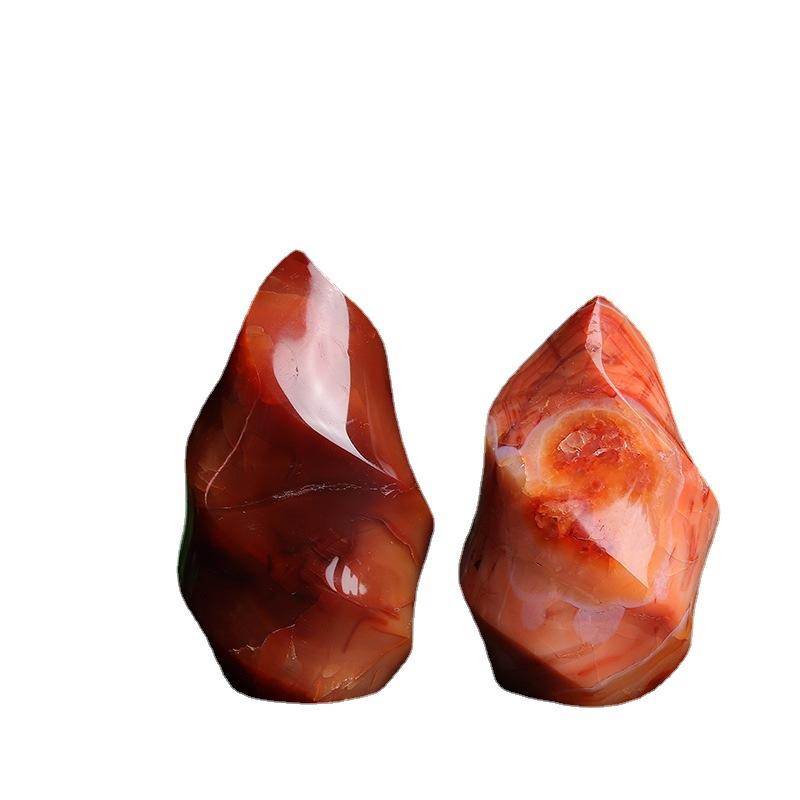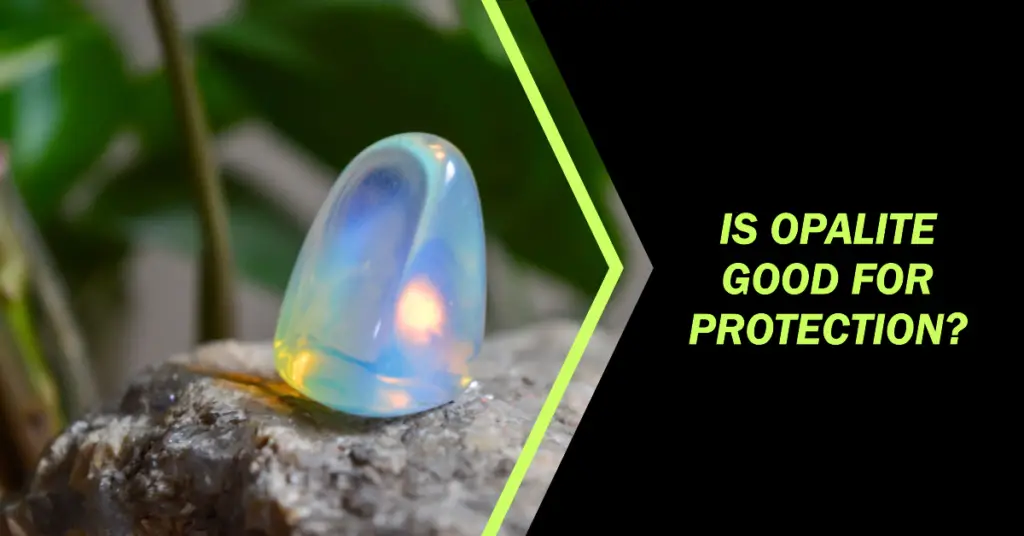When shopping for Carnelian, you may notice that it is categorized into different grades or levels of quality.
But what do these grades really mean and how is Carnelian categorized?
Understanding the factors that determine the value of Carnelian can help you pick the best specimen within your budget.
Factors affecting the grade of carnelian
Color is King
There is no doubt that color is an important factor in determining the grade and value of carnelian. The most valuable carnelian exhibits a rich orange-red or brownish-red color. Carnelian with a deep, translucent color commands a higher price than lighter, cloudy carnelian.
Mineral impurities that occur during the formation process give carnelian its lovely color. Iron oxide produces red and brown hues, while iron hydroxide produces a yellowish hue.
The shade of color depends on the concentration and oxidation state of these iron compounds. The more saturated the iron content, the deeper the red and brown hues.
Clarity Affects Quality
Like other quartz gemstones, carnelian is graded according to clarity or the absence of flaws and inclusions. Gemstones with high clarity and few visible flaws have a higher quality grade.
Under 10x magnification, the most transparent carnelian looks very clean. Lower grades of carnelian may show internal features such as two-phase inclusions, wispy veils and feathery cracks.
While even the finest carnelian will have some inclusions, excessive imperfections will reduce transparency and overall quality.
Cut Impacts Sparkle
The quality of the cut is also a factor in the grade of the carnelian. A finely cut and well-polished carnelian will show more brilliance and “fire” in the reflection of light. Correctly aligned cuts maximize the optical properties of carnelian.
Gemstones that are cut too shallow or too deep do not optimize the refractive index of carnelian. Poor cuts that are wavy, dull or unevenly faceted also reduce the attractiveness of carnelian.
A good cut brings out the inner beauty of carnelian, while a poor cut can have the opposite effect.
Size Affect Price
Larger carnelian gemstones and carvings have a higher market value, but carnelian is not like diamonds in that prices can vary greatly between sizes.
Common Carnelian Grading Methods
While it is well known that there is a universal grading system for diamonds that is strictly adhered to, there is no universally accepted evaluation system for colored gemstones.
Colored gemstones vary in color, clarity, etc., making it virtually impossible to grade all colored gemstones through predefined evaluation categories.
The “A’s” grading system
In order to differentiate between different qualities of carnelian, many sellers use the A rating system. This system uses “A” to indicate a quality stone, “AA” to indicate very good quality, and “AAA” to indicate truly outstanding quality.
Quality refers to the beauty and intensity of the stone’s color, its transparency (generally speaking, the higher the transparency, the better the quality), and the quality of the cut.
AAA
The highest quality carnelian gemstones exhibit a deep saturated orange-red color with high transparency and reflectivity. Their polished surfaces are smooth with no visible pits, marks or cracks.Grade AAA Carnelian is relatively expensive.
AA
Gemstones of this grade exhibit a beautiful orange-red color and are translucent. There may be minor imperfections on the surface, but they are not a problem when viewed casually. Under magnification, small crystals or veils may be faintly visible inside. Well-cut AA grade stones are moderately priced.
A
Grade A Carnelian has a lighter orange color and is less transparent. Clear surface abrasions or marks can be seen on close inspection. Inclusions such as clouds and feathers can be detected with a magnifying glass.

Descriptive grading Methods
Quality
The best carnelian exhibits a rich, pure orange-red color with high saturation and hue. Quality carnelian is skillfully faceted or polished. This top quality carnelian is very expensive.
Very good quality
This grade represents a beautiful medium to deep orange color. Inclusions such as tiny crystals can be seen under 10x magnification, but do not detract from the cleanliness of the appearance. Good carnelian is well cut and of high quality. Moderately priced.
Good quality
Fine carnelian is light orange to red in color with moderate saturation and clarity. Inclusions are evident but not numerous. The cut and polish are commercial grade. Fine Carnelian offers an affordable option for jewelry projects.
Fair quality
This lower grade ore is light orange in color and less saturated. Flaws such as cloudiness and feathery cracks are very visible under magnification. Cutting quality is not outstanding. Typical carnelian is inexpensive and sold in large quantities for craft use.
Poor quality
Poor quality carnelian lacks rich color. It has very visible internal flaws and poor cut quality. This low-end material sells for a low price and can be used for carving blanks and industrial purposes.
Classification certificate
For important carnelian specimens, accredited gemological laboratories such as GIA provide certification reports detailing weight, size, cut, color, clarity and other grading criteria.
These certificates verify the quality factors and standard grades assessed by professional gemologists.
Independent testing confirms whether or not the carnelian has undergone any overt enhancements. Certificates add credibility and can increase the price of quality graded gemstones.
Judging Carnelian Quality Yourself
Once you have some basic knowledge, you can evaluate the quality of carnelian for yourself with the following tips:
- Lighting – Check colors in daylight and incandescent light. Seek rich, saturated hues.
- Magnification – Use a 10x magnifying glass to check clarity characteristics. Avoid stones with excessive flaws.
- CUT – Looking for quality faceting and polishing. Prefer symmetrical contours and flat faceted joints.
- Size – The larger the size of the specimen the rarer and more valuable it is.
- Scratches – Marks on the surface can negatively affect clarity.
- Origin – Reliable origin and provenance enhance the value of the collection.
By knowing what factors professional gem labs use to grade carnelian, you can make an informed quality assessment before you buy. Look for dealers who offer grading information and shop around. With a discerning eye, you can find a gorgeous carnelian that suits your color preference and budget.
What does high quality carnelian look like?
To give you a better visualization of which carnelians are of higher quality, I’ve collected some high quality carnelian pictures for your reference.
You can compare the pictures with some of the previously stated grading criteria to give you a better understanding of what constitutes a high quality carnelian.
1) Etsy AAA Quality Natural Carnelian Smooth Oval Cabochon Gemstone

https://www.etsy.com/listing/963857623/aaa-quality-natural-carnelian-smooth
2) Replacements, LTD. Faceted Carnelian Ring

https://www.replacements.com/estate-jewelry-rings-10kw-faceted-carnelian-ring/p/127181681
3) 30X25 Mm Carvings Oval Red-Orange Carnelian

Caring for Carnelian
Carnelian requires some basic care to maintain its luster. Here are tips for keeping your carnelian in tip-top shape:
- Clean with warm water, neutral soap and a soft-bristled toothbrush to remove dirt and skin oils that dull the shine. Avoid harsh chemicals and abrasives that cause scratches.
- Rinse and dry thoroughly after cleaning. Residual moisture can damage the setting around the stone.
- Store carnelian separately from other gemstones and diamonds. Harder materials can scratch softer carnelian. Please place in a soft cloth bag.
- Avoid exposing carnelian to chemicals found in household cleaners and beauty products to avoid discoloration.
- Remove carnelian jewelry when engaged in physical or mechanical work. Shocks and impacts can destroy the soft components of carnelian.
- Keep your carnelian away from drastic temperature changes. Excessive heat and cold can cause breakage.
With regular cleaning and light handling, your Carnelian can be worn and enjoyed for a lifetime. Taking the proper precautions will preserve both the integrity of your carnelian and its natural warm luster.
About the Author
Nia Ivy is an intuitive empath, reiki healer, and certified yoga instructor. She teaches workshops on energy healing, developing intuition, and using yoga and meditation to tap into higher states of consciousness. Nia believes we all have innate healing abilities if we cultivate the self-awareness to access them. Her own spiritual awakening came through consistent mindfulness practices. She aims to hold space for others to find their inner light.




